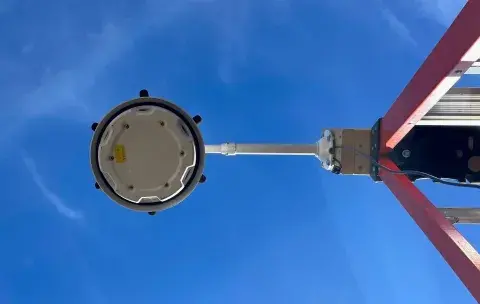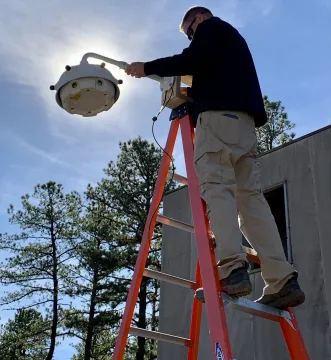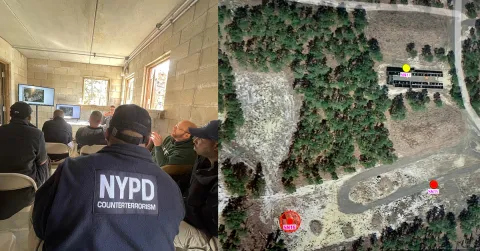New portable system employs two methods of detection for increased accuracy and reduced false positives.
New and improved gunshot detection technology will soon make American communities of all sizes safer. The Science and Technology Directorate (S&T) and its industry partner Shooter Detection Systems (SDS) developed SDS Outdoor, a gunshot detection system that builds on existing SDS technology to deliver new capabilities that significantly improve the response and management of outdoor shootings.
Among these new capabilities are portability and ease of system set up at any location, two-source detection—sound and flash—to confirm a gunshot, real-time alerts that provide near-instant situational awareness to law enforcement and emergency medical responders, and enhanced data recording that aids apprehension and conviction of alleged shooters.
Portability allows the system to be set up practically anywhere, including near outdoor events, and a single person can install it. Additionally, the enhanced system tells law enforcement when and where a gunshot originates, cutting response times dramatically and providing police officers actionable information—for example, data that helps them to determine if there is a single shooter or multiple shooters. Agencies can then use that information to coordinate resource response and counter an active threat.
“It takes about two to three minutes for an individual to call 911 after a gunshot. Gunshot detection technology cuts that time in half and sends a notification to local law enforcement. Police could then dispatch a unit quicker to either stop the incident that's occurring or to assist in preventing any lives being taken,” said Wilhelm Thomas, officer with the New York Police Department’s (NYPD) Counterterrorism Division. “If we're there first, we can lock down the scene. This will provide security for the emergency medical services (EMS) and thus help prevent the loss of more lives.”

Although gunshot detection technology is currently in use, it can only be installed at fixed locations. For outdoor public events, portable gunshot detection technology can add another layer of security to already installed security systems like cameras.
“This system does not prevent gunshots. It detects an ongoing shooting to help first responders get there faster,” said Anthony Caracciolo, S&T program manager for First Responder Technology. “The more details officers have about an incident, the quicker they can identify and eliminate the threat, and EMS can tend injured victims safely.”
More than two years ago, S&T’s First Responder Resource Group set out to extend gunshot detection capabilities to locations that do not support fixed deployments, such as open areas where large crowds may gather temporarily. Since then, the project has progressed into prototype design, gathering opinions from first responders, and, most recently, a November 2022 Operational Field Assessment (OFA) led by S&T’s National Urban Security Technology Laboratory (NUSTL).
“We started this project because most existing gunshot detection technologies come with limitations, and they may also trigger false alarms,” said Caracciolo. “An outdoor mobile detector that can be easily deployed in the field for a concert or other outdoor event is needed.”
Detecting gunshots almost instantly
SDS Outdoor has several interesting added features. For starters, one to two people can transport and install the system. Also, the tech delivers critical intelligence about an outdoor shooting incident almost instantaneously to first responders. Moreover, it dramatically reduces false-positive alerts.
“Unlike other detection systems, which mostly rely just on acoustics, our indoor gunshot detection system pairs two types of sensors—for the firearm’s infrared flash and acoustic bang—to get the false-alert rate way down,” said Richard Onofrio, SDS’ managing director. “We've applied that same concept to this development where we've increased the coverage area considerably.”
Prior to an outdoor event, officers can map out placement locations, install the system in minutes, and select the response agencies whom SDS Outdoor will alert if a shooting occurs.

As a plus, the gunshot detection tech’s alerting software integrates with the existing platforms used by first responders, including security cameras and dispatch systems. If internet is unavailable at an event site—no problem! The tech can communicate with the software application directly in more of a ‘local only’ mode.
“The SDS Outdoor system gives us that first line of awareness before we are dispatched that alerts us to where we need to go and how to get there and what resources we need to bring to it,” said Rick Carroll, also an officer with NYPD’s Counterterrorism Division. “If it's just one shot, you don't know if you only need one person or a team of two, or if it's multiple shots where you need the whole platoon to respond.”
SDS Outdoor works in the following way: When a gun is fired, the sensors detect the sound and flash and transmit the information wirelessly to its software application. Next, the application sends text alerts to individuals and/or agencies chosen beforehand with data such as the time and date of the gunshot, and specifics on the sound and flash waves. For multiple gunshots, the system sends multiple alerts. To increase law enforcement’s effectiveness, the gunshots appear on the screens of connected devices as color-coded dots on a map. The most recently fired shot is bright red, which gradually fades to orange and then yellow. This information helps law enforcement plan a more coordinated and effective response.
First responders give feedback
Even before S&T and SDS started designing SDS Outdoor, S&T consulted first responders on needed capability enhancements. “Advance input from emergency management professionals is important for a successful technology that serves them,” said Caracciolo.
“It's important for the government to reach out to local responders to get their viewpoints, because first responders are the experts in the field, and they will be using the technology,” said Chief Deputy Nicholas Lennie, Story County Sheriff's Office in Iowa.
During the OFA, S&T and SDS researchers collected critical feedback on design and functionality to ensure the final product meets the needs of responders and the communities they serve.
For the testing, first responders mounted SDS sensors on tall ladders outside and set up computers with the gunshot detection software in a nearby building. Outside, several shooters in different locations fired single shot rounds and multiple rapid-fire volleys within the safety protocols of the range. Meanwhile indoors, participants observed the gunshots appearing on the SDS system. The researchers also conducted false-positive tests with sounds that resembled gunshots—e.g., popping balloons, clappers, and nail guns.
At the end of the OFA, first responders evaluated the technology. They found that SDS Outdoor successfully detected the gunshots and provided insightful feedback on its functionality that SDS will implement to further improve their gunshot detection platform.

What’s next for the gunshot detection technology?
S&T will issue a report of the OFA test findings in June. SDS is now using the first-person feedback collected from the law enforcement officials who participated in the live testing to work on system improvements. The company expects a commercial version of an outdoor solution based on this development effort to be available to law enforcement agencies and first responders nationwide by the end of this year.
“Gunshot detection cannot be the only method of addressing gun violence. It is just one of the tools in the toolbox or one part of a comprehensive approach,” said Caracciolo. “It is important to collaborate with first responders and with industry in the development of a high-quality technology that first responders will actually use.”
Go deeper inside the SDS Outdoor field test in S&T’s Tech Speak podcast Shot Detected.
For related media inquiries, contact STMedia@hq.dhs.gov.
For more information about S&T’s first responder research and development portfolio visit https://www.dhs.gov/science-and-technology/first-responders-capability.
